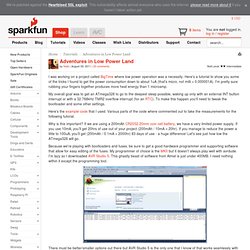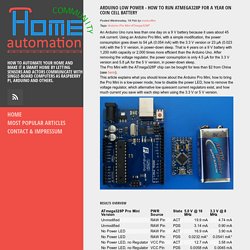

Adventures in Low Power Land. Skill Level: Intermediate by Nate | August 09, 2011 | 32 comments I was working on a project called BigTime where low power operation was a necessity.

Here's a tutorial to show you some of the tricks I found to get the power consumption down to about 1uA (that's micro, not milli = 0.000001A). I'm pretty sure rubbing your fingers together produces more heat energy than 1 microamp. My overall goal was to get an ATmega328 to go to the deepest sleep possible, waking up only with an external INT button interrupt or with a 32.768kHz TMR2 overflow interrupt (for an RTC). Here's the example code that I used. Why is this important? Because we're playing with bootloaders and fuses, be sure to get a good hardware programmer and supporting software that allow for easy editing of the fuses.
There must be better/smaller options out there but AVR Studio 5 is the only one that I know of that works seamlessly with my MKII programmer and the ATmega328. make clean make atmega328_pro8 Whoa. 1uA. 1) The DMM. Arduino Low Power - How To Run ATmega328P For a Year On Coin Cell Battery. An Arduino Uno runs less than one day on a 9 V battery because it uses about 45 mA current.

Using an Arduino Pro Mini, with a simple modification, the power consumption goes down to 54 μA (0.054 mA) with the 3.3 V version or 23 μA (0.023 mA) with the 5 V version, in power-down sleep. That is 4 years on a 9 V battery with 1,200 mAh capacity or 2,000 times more efficient than the Arduino Uno. After removing the voltage regulator, the power consumption is only 4.5 μA for the 3.3 V version and 5.8 μA for the 5 V version, in power-down sleep. The Pro Mini with the ATmega328P chip can be bought for less than $2 from China (see here). This article explains what you should know about the Arduino Pro Mini, how to bring the Pro Mini in a low-power mode, how to disable the power LED, how to remove the voltage regulator, which alternative low quiescent current regulators exist, and how much current you save with each step when using the 3.3 V or 5 V version.
Results Overview. Adventures in Low Power Land. Tout ce que vous pourriez vous demander sur la consommation d'une puce ATmega328p (puce d'Arduino) Consommation d'un Arduino, et optimisation d'un montage à base de ATmega328PJe vous propose ici un résumé d'un excellent article que j'ai lu sur le net.

Je tiens avant tout à dire que tout ce que je vais présenter ici provient du travail de Nick Gammon, sur le lien ci dessous :Sur cette page de Nick Gammon, se trouve un post d'immense qualité sur la consommation des ATmega328P, et les moyens d'optimiser celle ci.Si vous comprenez l'anglais, allez plutôt lire l'original, et au pire gardez le lien vers ce résumé pour les tables, et formules L'auteur y mène une investigation poussée sur ce que consomme un Ardruino, puis surtout un ATmega328P sur une breadboard. Bien sur, le Arduino consomme plus que la version breadboard. On passe en effet de 55mA pour le Arduino Uno a 15mA pour le Arduino "breadboard". Il présente ensuite d'autres optimisations permettant de baisser encore la consommation.
Et si ça ne suffit pas, il optimise encore (toujours en mode veille) jusqu'à 125 nano ampères. Gammon Forum : Electronics : Microprocessors : Power saving techniques for microprocessors. Summary In this thread I show various power-saving techniques for the Atmega328P processor.

They include sleep modes, use of power-reduction registers, and other techniques. Applying all of them can result in a current draw as low as approximately 100 nano-amps (100 nA), well below the self-discharge rate of most batteries. Proof from the datasheet for the Atmega328P (page 405 of my copy): That is 100 nA at at 25°C running at 3v. These techniques would be useful for battery-powered devices where the full power of the processor was only required intermittently, for example a TV remote, calculator, doorbell, or some sort of environmental monitor where you only needed to check things from time to time.
Introduction I am going to explore various power-saving options for running your project, presumably from battery power. These examples are specifically for the Atmega328P processor, but the techniques are pretty general. Summary of methods Baseline - Arduino Uno Sketch A Sketch B Bare-bones board.